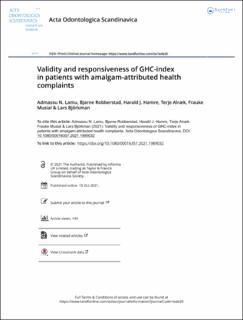Validity and responsiveness of GHC-index in patients with amalgam-attributed health complaints
Lamu, Admassu Nadew; Robberstad, Bjarne; Hamre, Harald Johan; Alræk, Terje; Musial, Frauke; Björkman, Lars
Journal article, Peer reviewed
Published version

Åpne
Permanent lenke
https://hdl.handle.net/11250/2829608Utgivelsesdato
2022Metadata
Vis full innførselSamlinger
Originalversjon
Acta Odontologica Scandinavica, 2022, 80 (3), 226-233. 10.1080/00016357.2021.1989032Sammendrag
Objective: Many patients have medically unexplained physical symptoms (MUPS); some of them attribute their health complaints to dental amalgam fillings. The aim of this study was to assess the validity and responsiveness of General Health Complaints index (GHC-index) for measuring the symptom load in MUPS patients compared to the widely used symptom outcome measure, Giessen Subjective Complaints List (GBB-24).
Methods: Three outcome measures – GHC-index, GBB-24, and Munich Amalgam Scale (MAS) – were administered at baseline and 12 months after removal of all dental amalgam restorations. The validity and responsiveness of these symptom measures were tested against external anchors: bodily distress syndrome (BDS), SF-36 vitality, and visual analogue scale (VAS). We tested both convergent and known group validities. We also examined the predictive validity and responsiveness to changes for each instrument.
Results: All the main outcome measures showed evidence of convergent and known group validities. The GHC-index, GBB-24 and MAS were all able to detect the anticipated differences in BDS and Energy. But the GBB-24 was more efficient in discriminating the BDS compared with the GHC-index (relative efficiency: RE = 0.69; 95% CI: 0.41–0.96) and MAS (RE = 0.59; 95% CI: 0.32–0.86). Each main outcome variable revealed good predictive validity for vitality (standardized coefficient: b ≈ 0.71 and R2 ≈ 0.50). Moderate to high sensitivity to change over time was demonstrated, with GHC-index performing better.
Conclusion: The GHC-index is a valid and responsive instrument for assessing symptom load in MUPS patients attributing their health complaints to amalgam fillings and undergoing amalgam removal.
